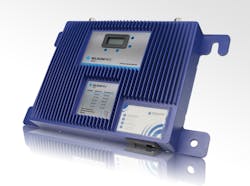Wilson Electronics positions cellular signal dual-booster system as DAS alternative
At last month's CEDIA 2016 (Sep. 6-9), Wilson Electronics debuted its WilsonPro 1000/1050 cellular signal booster system. The company contends that "this new product line solidifies WilsonPro as an innovative, smart alternative to expensive DAS rollouts, accomplishing the same objectives of better cellular service with less work and lower costs."
According to a product press release, "Wilson Electronics’ team of engineers designed the WilsonPro 1000/1050 to address the issue of reduced system performance due to the loss of cell signals over unavoidable, long coax cable lines, a common issue in large buildings. The [unit's] two-booster design, comprised of a main booster and inline booster, provides up to 32x stronger signal in offices and large buildings, ensuring maximum indoor coverage, faster download and upload speeds, and no more dropped calls. The system’s dual-booster design consists of four parts – two boosters and two antennas – that work together to provide exceptional mobile connectivity. Unlike most single booster designs, WilsonPro 1000/1050 boosters communicate with one another to mitigate signal loss, so those in the building can enjoy maximum indoor coverage."
“Our two-unit system of the WilsonPro 1000 in combination with the WilsonPro 1050 is the industry’s first ‘intelligent’ system. It enhances all cellular signals simultaneously while greatly extending the reach in a large building where cable loss would otherwise negate the system performance of a standard booster,” explains Jeff Gudewicz, vice president, corporate development at Wilson Electronics. “This technology allows these units to communicate over the same coax used to pass RF frequencies, giving installers an option for delivering reliable connectivity without adding complexity of cabling and installation.”
As for how the system works specifically, Gudewicz adds, "The WilsonPro 1000, the main booster, amplifies the cell signal, and the 1050, the supplementary inline booster, restores any signal lost. An indoor antenna communicates with cellular devices inside the space, and an outdoor antenna communicates with the cell tower. While the WilsonPro 1050 relies on the 1000 to function, the 1000 does work as a standalone booster. The WilsonPro 1000 and 1000/1050 are independently tested and carrier agnostic, providing coverage through every corner and level of large buildings for all U.S. and Canadian phone carriers, including 4G LTE enabled devices."
The WilsonPro 1000/1050 system is expected to be available for purchase through WilsonPro certified resellers this December. The system is WilsonPro’s second booster solution specifically designed for enterprise IT professionals’ needs. Most recently, the WilsonPro 4000/4000R set the standard with its easy-to-manage booster with four amplification ports made to maximize enhanced cellular coverage and XDR technology for extended dynamic range. For more information, visit www.wilsonpro.com.
Search the Cabling Installation & Maintenance Buyer's Guide for companies, new products, press releases, and videos:
